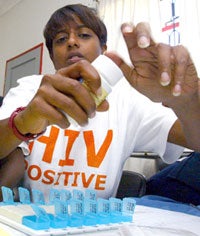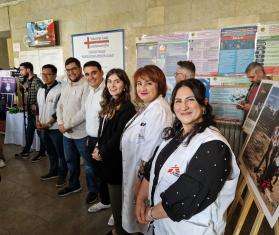Why it's High Time to Change the Rules of the Game

At General Hospital in Lagos, Nigeria, MSF treats people living with HIV using antiretroviral therapy (ARVs), as well as counseling. © David Levene |
Much of this is due to the research and development (R&D) paradigm that exists today. Pharmaceutical companies argue that strong intellectual property protection, backed up by patents and data exclusivity and entrenched in international trade agreements, is necessary to pay for R&D. The rationale of this model is simple: patents provide time-limited exclusivity to the inventors of a product to reap its commercial benefits. This is a way of encouraging companies to invest in innovation, and ultimately benefits society as a whole.
So much for the theory. The reality Doctors Without Borders/Médecins Sans Frontières (MSF) witnesses every day in its field programs tells a different story. Firstly, patents create a monopoly for drug companies, and in the absence of competition, firms can price their products in a way that maximizes revenue — at the expense of patients. The impact of competition on the prices of HIV/AIDS medicine shows how access to life saving treatments can vastly improve once this monopolistic situation is ended and generic competition can begin (see figure 1).
Secondly, if medical R&D is predominantly funded by the profits generated from marketing products, it follows that companies will naturally seek to invest in research for products that maximize potential returns. When R&D is driven into areas of profitability, the research for treatments which don't hold much promise of profits — because the sufferers of that disease are overwhelmingly poor, for example — simply doesn't take place. Neglected diseases are the most striking example of this failure (see box A).
But this is not simply a problem of poverty — rich patients are affected too.
Because of how R&D is rewarded today, it makes more sense in profit terms for a drug manufacturer to develop a drug with no added therapeutic benefit for a particular condition, even if there already is a drug on the market for that same condition. Research activities are therefore wasted on the development of so-called me-too drugs (see box), when at the same time, vast areas of medical need are not being addressed. The Priority Medicines report published by WHO in 2004 raised these issues convincingly.
That the current global system for supporting innovation in new medicines and other health technologies is inadequate, was clearly reflected in the establishment by WHO in 2003 of the Commission on Intellectual Property, Innovation and Public Health (CIPIH). The Commission was asked to "produce an analysis of intellectual property rights, innovation and public health, including the question of appropriate funding and incentive mechanisms for the creation of new medicines and other products against diseases that disproportionately affect developing countries." The CIPIH published a comprehensive report of its findings in April of this year.
Its conclusions on the impact that patents and international trade agreements have on access to medicines, and on the role that governments should play on this issue, speak for themselves. The report concludes that intellectual property is irrelevant in stimulating innovation for many of the diseases affecting people in developing countries, where patients have limited purchasing power. Further, the report draws attention to the fact that patents can actually hamper innovation, by blocking follow-on research or access to research tools. It also points out that even in regions with strong intellectual property protection, innovation results are declining.
"The CIPIH report clearly signals that innovation is meaningless if the people who need it do not have access to it," said Ellen 't Hoen, Director of Policy and Advocacy at MSF's Campaign for Access to Essential Medicines. "One message that comes through loud and clear from the report is that governments have to be proactive and ensure that health R&D does meet the needs of patients, and that newly developed products are accessible and affordable to those that need them."
Only with comprehensive reform of the current R&D system for essential health tools will that be possible. One immediate way to address these issues is for governments and WHO to promote the proposals made by Kenya and Brazil for a "Global Framework for Essential Health R&D." The proposal, submitted to the WHO Executive Board in January 2006, will be debated at the World Health Assembly in Geneva. It calls on WHO to facilitate talks between interested governments, on establishing new international mechanisms that ensure that medical R&D is driven by health needs, and delivers products that are appropriate, affordable and accessible. Such time-bound discussions are necessary if governments are serious about acting on their responsibility to ensure greater access to medical innovations for all.
The R&D system is still not delivering on neglected diseases
- Between 1975 and 1999, a total of 1,393 new chemical entities were marketed globally. Less than 1 percent of these were for neglected diseases and tuberculosis–diseases which account for 12 percent of the total disease burden.
- Many argue that the situation has changed since then–but the facts disprove them. An article published in the Lancet this month shows how, updated to include the years from 1999 through 2004, of the 1,556 new chemical entities, only 20 new drugs —again a mere 1 percent— were for tropical diseases and tuberculosis.
- Product development partnerships (PDPs) devoted to drug development may have filled their pipelines with compounds that address neglected diseases, but without greater and long-term public funding of these initiatives, these promising candidate drugs will stay where they are — in the pipeline. Today, governments contribute barely 16 percent of PDPs' funding, whereas philanthropic organizations provide 79 percent.
The R&D system fails patients in rich countries too: the prevalence of "me-too" drugs

MSF physician Prinitha Pillay prepares a week's worth of ARV medications for a patient under treatment at the MSF project in Lesotho. © Wayne Conradie |
- In Canada, a study published in the British Medical Journal rated barely five percent of all newly-patented drugs approved in the country as "breakthrough." Alarmingly, drugs classified as "me-too," meaning that they have no added therapeutic benefit, were responsible for 80 percent of the soaring rise in prescription costs experienced in the country. This provides a telling illustration of the waste in a system that rewards innovations that provide little or no therapeutic gain.
- A survey published in April 2005 by La Revue Prescrire, assessing the 3,096 new products approved for the French market between 1981 and 2004, concluded that 68 percent brought "nothing new" compared to previously available preparations.
- A breakdown of the 1,035 new drugs approved by the United States Food and Drug Administration (FDA) between 1989 and 2000 revealed that more than three quarters are classed as having no therapeutic benefit over existing products.



